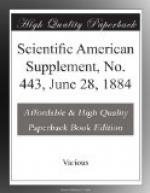very beautifully; electrify further, and the air is
perfectly clear. Next burn turpentine, and electrify
gently; the dense black smoke coagulates into black
masses over an inch long; electrify further, and the
glass is covered with soot, but the air is clear.
Turpentine smoke acts very well, and can be tried
on a larger scale; a room filled with turpentine smoke,
so dense that a gas-light is invisible inside it,
begins to clear in a minute or two after the machine
begins to turn, and in a quarter of an hour one can
go in and find the walls thickly covered with stringy
blacks, notably on the gas-pipes and everything most
easily charged by induction. Next fill a bell-jar
full of steam, and electrify, paying attention to
insulation of the supply point in this case.
In a few seconds the air looks clear, and turning on
a beam of light we see the globules of water dancing
about, no longer fine and impalpable, but separately
visible and rapidly falling. Finally, make a
London fog by burning turpentine and sulphur, adding
a little sulphuric acid, either directly as vapor
or indirectly by a trace of nitric oxide, and then
blowing in steam. Electrify, and it soon becomes
clear, although it lakes a little longer than before;
and on removing the bell-jar we find that even the
smell of SO2 has disappeared, and only a little vapor
of turpentine remains. Similarly we can make
a Widnes fog by sulphureted hydrogen, chlorine, sulphuric
acid, and a little steam. Probably the steam assists
the clearing when gases have to be dealt with.
It may be possible to clear the air of tunnels by
simply discharging electricity into the air—the
electricity being supplied by Holtz machines, driven
say by small turbines—a very handy form
of power, difficult to get out of order. Or possibly
some hydro-electric arrangement might be devised for
the locomotive steam to do the work. I even hope
to make some impression on a London fog, discharging
from lightning conductors or captive balloons carrying
flames, but it is premature to say anything about
this matter yet. I have, however, cleared a room
of smoke very quickly with a small hand machine.
It will naturally strike you how closely allied these
phenomena must be to the fact of popular science that
“thunder clears the air.” Ozone is
undoubtedly generated by the flashes, and may have
a beneficial effect, but the dust-coagulating and
dust-expelling power of the electricity has a much
more rapid effect, though it may not act till the
cloud is discharged. Consider a cloud electrified
slightly; the mists and clouds in its vicinity begin
to coagulate, and go on till large drops are formed,
which may be held up by electrical action, the drops
dancing from one cloud to another and thus forming
the very dense thunder cloud. The coagulation
of charged drops increases the potential, as Prof.
Tait points out, until at length—flash—the
cloud is discharged, and the large drops fall in a
violent shower. Moreover, the rapid excursion
to and fro of the drops may easily have caused them
to evaporate so fast as to freeze, and hence we may
get hail.




